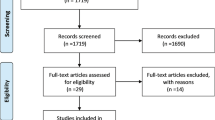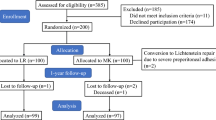Abstract
Background
The aim of this study was to assess whether the application of a lightweight mesh for mesh plug repair (MPR) for primary inguinal hernia could reduce chronic pain or other symptoms associated with the insertion of the prosthesis.
Methods
Patients over 20 years of age with a unilateral primary inguinal hernia were eligible to participate in the study. The patients were randomly assigned to a lightweight mesh (LWM) or a heavyweight mesh (HWM) group. All the operations were performed under local anesthesia. The operative details, including the hernia type and the nerves that were identified, and the postoperative complications were recorded. All follow-up and outcome measures were obtained based on a physical examination and a questionnaire regarding pain and other symptoms at 1 week, 1, 3, 6, and 12 months after the surgery in a double-blinded manner.
Results
The use of LWM significantly reduced foreign body sensation after 12 months to one-third of the incidence reported for the use of HWM (5.8 vs. 17.9 %; P = 0.013), while no significant differences were found in pain parameters, including the use of pain relief medications, between the groups throughout the study period.
Conclusion
This study indicated that the use of LWM in the MPR decreases the incidence of foreign body sensation at 1 year after surgery for primary inguinal hernia. LWM may be preferable to MPR, similar to results described previously for Lichtenstein repair.



Similar content being viewed by others
References
Bay-Nielsen M, Kehlet H, Strand L, Malmstrom J, Andersen FH, Wara P et al (2001) Quality assessment of 26,304 herniorrhaphies in Denmark: a prospective nationwide study. Lancet 358:1124–1128
Awad SS, Fagan SP (2004) Current approaches to inguinal hernia repair. Am J Surg 188:9S–16S
O’Dwyer PJ, Kingsnorth AN, Molloy RG, Small PK, Lammers B, Horeyseck G (2005) Randomized clinical trial assessing impact of a lightweight or heavyweight mesh on chronic pain after inguinal hernia repair. Br J Surg 92:166–170
Post S, Weiss B, Willer M, Neufang T, Lorenz D (2004) Randomized clinical trial of lightweight composite mesh for Lichtenstein inguinal hernia repair. Br J Surg 91:44–48
Bringman S, Wollert S, Osterberg J, Smedberg S, Granlund H, Heikkinen TJ (2006) Three-year results of a randomized clinical trial of lightweight or standard polypropylene mesh in Lichtenstein repair of primary inguinal hernia. Br J Surg 93:1056–1059
Sajid MS, Leaver C, Baig MK, Sains P (2012) Systematic review and meta-analysis of the use of lightweight versus heavyweight mesh in open inguinal hernia repair. Br J Surg 99:29–37
Uzzaman MM, Ratnasingham K, Ashraf N (2012) Meta-analysis of randomized controlled trials comparing lightweight and heavyweight mesh for Lichtenstein inguinal hernia repair. Hernia 16:505–518
Lichtenstein IL, Shulman AG, Amid PK, Montllor MM (1989) The tension-free hernioplasty. Am J Surg 157:188–193
Zhao G, Gao P, Ma B, Tian J, Yang K (2009) Open mesh techniques for inguinal hernia repair: a meta-analysis of randomized controlled trials. Ann Surg 250:35–42
Nienhuijs SW, van Oort I, Keemers-Gels ME, Strobbe LJ, Rosman C (2005) Randomized trial comparing the Prolene Hernia System, mesh plug repair and Lichtenstein method for open inguinal hernia repair. Br J Surg 92:33–38
Frey DM, Wildisen A, Hamel CT, Zuber M, Oertli D, Metzger J (2007) Randomized clinical trial of Lichtenstein’s operation versus mesh plug for inguinal hernia repair. Br J Surg 94:36–41
Nienhuijs S, Kortmann B, Boerma M, Strobbe L, Rosman C (2004) Preferred mesh-based inguinal hernia repair in a teaching setting: results of a randomized study. Arch Surg 139:1097–1100
Dalenback J, Andersson C, Anesten B, Bjorck S, Eklund S, Magnusson O et al (2009) Prolene Hernia System, Lichtenstein mesh and plug-and-patch for primary inguinal hernia repair: 3-year outcome of a prospective randomised controlled trial. The BOOP study: bi-layer and connector, on-lay, and on-lay with plug for inguinal hernia repair. Hernia 13:121–129
Robbins AW, Rutkow IM (1998) Mesh plug repair and groin hernia surgery. Surg Clin North Am 78:1007–1023
Klosterhalfen B, Junge K, Klinge U (2005) The lightweight and large porous mesh concept for hernia repair. Expert Rev Med Devices 2:103–117
Silvestre AC, de Mathia GB, Fagundes DJ, Medeiros LR, Rosa MI (2011) Shrinkage evaluation of heavyweight and lightweight polypropylene meshes in inguinal hernia repair: a randomized controlled trial. Hernia 15:629–634
Amid PK (2004) Causes, prevention, and surgical treatment of postherniorrhaphy neuropathic inguinodynia: triple neurectomy with proximal end implantation. Hernia 8:343–349
Mui WL, Ng CS, Fung TM, Cheung FK, Wong CM, Ma TH et al (2006) Prophylactic ilioinguinal neurectomy in open inguinal hernia repair: a double-blind randomized controlled trial. Ann Surg 244:27–33
Ravichandran D, Kalambe BG, Pain JA (2000) Pilot randomized controlled study of preservation or division of ilioinguinal nerve in open mesh repair of inguinal hernia. Br J Surg 87:1166–1167
Dittrick GW, Ridl K, Kuhn JA, McCarty TM (2004) Routine ilioinguinal nerve excision in inguinal hernia repairs. Am J Surg 188:736–740
Pappalardo G, Guadalaxara A, Illomei G, d’Orta C, Frattaroli FM (1999) Prevention of postherniorrhaphy persistent pain: results of a prospective study. Int Surg 84:350–353
Pappalardo G, Frattaroli FM, Mongardini M, Salvi PF, Lombardi A, Conte AM et al (2007) Neurectomy to prevent persistent pain after inguinal herniorraphy: a prospective study using objective criteria to assess pain. World J Surg 31:1081–1086
Alfieri S, Rotondi F, Di Giorgio A, Fumagalli U, Salzano A, Di Miceli D et al (2006) Influence of preservation versus division of ilioinguinal, iliohypogastric, and genital nerves during open mesh herniorrhaphy: prospective multicentric study of chronic pain. Ann Surg 243:553–558
Beldi G, Haupt N, Ipaktchi R, Wagner M, Candinas D (2008) Postoperative hypoesthesia and pain: qualitative assessment after open and laparoscopic inguinal hernia repair. Surg Endosc 22:129–133
Bringman S, Ramel S, Heikkinen TJ, Englund T, Westman B, Anderberg B (2003) Tension-free inguinal hernia repair: TEP versus mesh-plug versus Lichtenstein: a prospective randomized controlled trial. Ann Surg 237:142–147
Singh AN, Bansal VK, Misra MC, Kumar S, Rajeshwari S, Kumar A et al (2012) Testicular functions, chronic groin pain, and quality of life after laparoscopic and open mesh repair of inguinal hernia: a prospective randomized controlled trial. Surg Endosc 26:1304–1317
Neumayer L, Giobbie-Hurder A, Jonasson O, Fitzgibbons R Jr, Dunlop D, Gibbs J et al (2004) Open mesh versus laparoscopic mesh repair of inguinal hernia. N Engl J Med 350:1819–1827
Memon MA, Cooper NJ, Memon B, Memon MI, Abrams KR (2003) Meta-analysis of randomized clinical trials comparing open and laparoscopic inguinal hernia repair. Br J Surg 90:1479–1492
Neumayer LA, Gawande AA, Wang J, Giobbie-Hurder A, Itani KM, Fitzgibbons RJ Jr et al (2005) Proficiency of surgeons in inguinal hernia repair: effect of experience and age. Ann Surg 242:344–348 (discussion 348–352)
Langeveld HR, van’t Riet M, Weidema WF, Stassen LP, Steyerberg EW, Lange J et al (2010) Total extraperitoneal inguinal hernia repair compared with Lichtenstein (the LEVEL-trial): a randomized controlled trial. Ann Surg 251:819–824
Conflict of interest
TH declares that his institution has received a grant support for this study from Johnson & Johnson company. YT declares no conflict of interest. SK declares that his institution has received a grant support for this study from Johnson & Johnson company. YS declares that his institution has received a grant support for this study from Johnson & Johnson company. ES declares that his institution has received a grant support for this study from Johnson & Johnson company. SN declares that his institution has received a grant support for this study from Johnson & Johnson company. HH declares that his institution has received a grant support for this study from Johnson & Johnson company.
Author information
Authors and Affiliations
Corresponding author
Rights and permissions
About this article
Cite this article
Hirose, T., Takayama, Y., Komatsu, S. et al. Randomized clinical trial comparing lightweight or heavyweight mesh for mesh plug repair of primary inguinal hernia. Hernia 18, 213–219 (2014). https://doi.org/10.1007/s10029-013-1105-8
Received:
Accepted:
Published:
Issue Date:
DOI: https://doi.org/10.1007/s10029-013-1105-8




